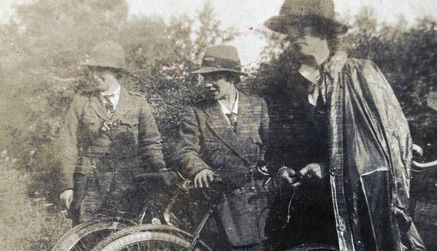Military Service (1916 - 1921) Pensions Collection
Women in 1916
“Dress suitably in short skirts and sitting boots, leave your jewels and gold wands in the bank, and buy a revolver.”
Themes: Female Participation Sub-themes:
Subject: History,English Language: English
Estimated Number of Classes: 2-3
Toolkit: Projector,Internet Connection,Computer Lab,Print Outs,Post-its

Abstract:
This lesson plan will enable students to explore the background to the role that women played during the Easter Rising and their motivation for becoming involved in revolutionary activity. Students will also gain insights into the wider social attitudes to women. Students will be introduced to Cumann na mBan in particular, and will examine the organisation's origins and aims. Students will develop an appreciation of the importance of utilising primary sources.
Lesson Aims/Objectives:
a. To explore the role of female participation in the Easter Rising
b. To learn about and understand the role of women in 1916, their motivation, and contemporary attitudes to women
c. To examine the aims and origins of Cumann na mBan
d. To develop an appreciation of the use of primary sources
Advanced Preparation Required:
a. Teacher should make sure they can access the RTÉ footage (see Materials Needed section ‘b’) and access the Dictionary of Irish Biography
b. Teacher should print off copies of the Cumann na mBan Constitution (pdf pages 27‐28), the pension file of Gretta Mullins, member of Cumann na mBan (pdf pages 22‐23) and pension file of Rosana/Rose Hackett, member of the Irish Citizen Army and the pension file of Ellen Sarah Bushell who had a number of affiliations, not typical to a woman at that time. Teacher should distribute one document per group at least (see Materials Needed 10. ‘c’, ‘d’, ‘e’ and ‘f’).
c. Teacher should provide a variety of coloured sticky notes (3 colours) to assist exercise one.
Methodology:
a. Exercise One:
i. Put provided image of Countess Markievicz in Irish Citizen Army uniform (see Materials Needed 10. ‘a’) on the projector and ask students to identify the things they notice about the picture (i.e. What they see, think and wonder). Teacher then introduces Countess Markievicz with a very brief synopsis of her involvement in the 1916 Rising. Access to the Dictionary of Irish biography should assist.
ii. Watch short RTÉ clip on the Cumann na mBan centenary (see Materials Needed 10. ‘b’). Students will need to identify three things from the clip
- Attitudes to women in the nationalist movement
- Motivational factors for women
- Divergences within the female nationalist movement
a. Class
b. Political
iii. Students write their answers on different colour sticky notes (the teacher should determine what colour connects with a specific topic) and stick them up in different parts of the classroom based on colour
iv. When all groups have posted their answers one student is assigned a section and reads out the answers given
v. Teacher leads a class discussion based on the students’ observations
b. Exercise Two:
i. This exercise can take place in the following lesson and could be extended into a third lesson if a more formal presentation is produced.
ii. Divide students into groups depending on class size
iii. Provide each group with a copy of the Cumann na mBan Constitution, Gretta Mullins’ pension file, Rosana Hackett’s pension file and Ellen Sarah Bushell’s pension file (see Materials Needed 10. ‘c’, ‘d’, ‘e’ and ‘f’)
iv. Each group will be given several minutes to discuss what they notice about the documents / what they find interesting / what they tell them about the perceived and actual role or position of women in 1916. If the printed resources are not being reused, students could be encouraged to annotate and highlight relevant sections.
v. Each group will prepare a brief presentation of their findings ‐ this could be an extended task with a visual presentation if time and resources allow.
vi. Each group will present their findings to the class using the evidence from the constitution and pension file to support their conclusions
Assessment:
a. Informal assessment of students during group work in exercise one.
b. Class understanding of the concepts assessed during the presentation of exercise one, any misconceptions can be addressed by the teacher prior to moving on to exercise two.
c. Students peer‐review group presentations from exercise two.
d. Teacher can assess the group presentations from exercise two, and identify areas which need to be consolidated. Questioning should be used to extend student responses and test knowledge in order to establish whether further inquiry is needed.
Materials Needed:
a.Image of Constance Markievicz
b.RTE video clip about female participation and the origins of Cumann na mBan
c.Copy of Cumann na mBan constitution (pdf pages 27‐28)
d.Pension file of Gretta Mullins (pdf pages 22‐23)
e.Pension file of Rosana/Rose Hackett (pdf pages 21 ‐ 26)
f.Pension file of Ellen Sarah Bushell (pdf pages 30‐32, 36‐37)
Funded/developed by
Developed by The Letters of 1916 Project, The Military Archives, An Foras Feasa and The Humanities Institute at Maynooth University. Funded by the Department of Education and Skills and the Irish Research Council.
 <200b>img-responsive">
<200b>img-responsive"> <200b>img-responsive pull-right">
<200b>img-responsive pull-right">

